Dr. Mario García, world-renowned design consultant, Senior Adviser for News Design, and Adjunct Professor at Columbia University’s School of Journalism, speaks exclusively with TK Sajeev, Editorial Director of newspaperdesign.org, on one of the most pressing topics of our time — the future of print media.
As the CEO and founder of García Media, Dr. MarioGarcía has led the redesign of over 750 publications across 120 countries. He is also the author of 15 books, including his latest: “AI: The Next Revolution in Content Creation.”
How do you perceive the current role of print media in an increasingly digital news ecosystem?
Print remains a vital component of the operations for thousands of media houses worldwide, with over 17,000 businesses active in the global newspaper publishing industry as of 2024.
I can’t remember the number of times that my clients tell me to take good care of the print product, because it is still the cash cow. Despite the digital shift, print circulation and advertising still account for nearly 45% of publishers’ revenues on average. Just think that global print newspaper and magazine revenues are projected to reach $108.38 billion in 2025. Advertisers, particularly those targeting affluent audiences, are still in love with printed newspapers; for instance, 70% of households earning over $100,000 annually read newspapers, making print a premium channel for high-value brand exposure. Globally, newspaper advertising spending is forecasted to hit $22.66 billion in 2025. Luxury brands, in particular, leverage print’s tactile appeal and credibility, with examples like Cartier and Louis Vuitton frequently investing in high-end newspaper supplements; in 2024, similar campaigns included collaborations such as Audi’s multi-article features in luxury media titles, which generated substantial revenue through print placements. Just consider the Sunday New York Times print edition, which boasts an average paid circulation of 623,000 copies in 2024 and often arrives wrapped in 4- or 8-page advertising supplements from major global brands. For The New York Times itself, print operations contributed over $750 million in revenue in 2023—about one-third of its total—highlighting how print advertising, despite a 12.4% year-over-year decline in 2024, remains a key pillar for sustaining overall growth. So, as you can see these numbers tell us that it is too early to plan a printed newspaper’s funeral. Quite the contrary.
Is there still a unique value that print brings to journalism that digital cannot fully replace?
First, the permanence of print imposes a heightened sense of accountability on journalists. Knowing their words will be indelibly fixed in ink, reporters and editors exercise greater diligence in verifying facts, refining prose, and ensuring narrative coherence. A 2023 study by the Poynter Institute noted that print editions, due to their fixed nature, undergo more rigorous editorial scrutiny compared to digital articles, which can be amended post-publication with relative ease. This fosters a culture of precision, as errors in print cannot be erased with a quick edit but remain as a lasting testament to the publication’s credibility—or lack thereof. Digital journalism, by contrast, often operates under the pressure of immediacy, where the ability to revise can inadvertently lower the threshold for initial accuracy.
Beyond the production process, print offers a singularly immersive reader experience, which can be described as a “lean-back” ritual. Engaging with a physical newspaper is a tactile, deliberate act—unfolding pages, feeling the texture of newsprint, and inhaling its faint, inky scent. This sensory engagement, as noted in a 2024 study on media consumption habits, enhances reader focus and emotional connection to content, with 68% of print readers reporting deeper comprehension compared to digital formats. Unlike the frenetic, interruptive nature of digital platforms—where notifications, pop-up ads, and social media alerts fragment attention—print invites uninterrupted contemplation. The act of reading a newspaper is a disciplined ritual, free from what I refer to as the “journalism of interruptions” that characterizes digital consumption, where 75% of smartphone users report checking their devices at least once every 10 minutes while reading news online.
What changes have you observed in reader behavior toward print in recent years?
I think the most noticeable change is how readers come to print with some expectations derived from their digital reading experiences. They wish to find better navigational systems in print as in let me find the content quicker. They expect more visuals, and bigger photos, since photos on a phone screen tend to be small. In recent years, reader behavior toward print journalism has undergone subtle but significant shifts, largely influenced by the conventions and immediacy of digital media consumption. These changes reflect an adaptation of expectations shaped by digital platforms, as readers increasingly seek a print experience that aligns with the navigational ease and visual richness they encounter online.
One prominent shift is the demand for enhanced navigational efficiency in print publications. Readers, accustomed to the hyperlinked, search-driven interfaces of digital news platforms, now expect print editions to facilitate quicker access to content. A 2024 survey by the World Association of News Publishers found that 65% of print readers desire clearer section demarcations, bolder headlines, and more intuitive layouts to streamline their reading experience, mirroring the ease of digital navigation. This is a departure from the traditional, linear progression of print, as readers now favor designs that allow them to locate stories with the same speed and precision they experience when browsing apps or websites. For instance, newspapers like The Guardian have responded by incorporating more prominent tables of contents and color-coded sections in their print editions since 2023, improving content discoverability.
Additionally, readers increasingly expect print to deliver a visually richer experience, driven by their exposure to the constraints of digital screens. On smartphones, where images are often compressed or limited by screen size, readers crave the expansive, high-impact visuals that print can offer. Print readers value larger, high-resolution photographs and infographics in newspapers, as these elements provide a visual depth often unattainable on smaller digital displays.The New York Times and Le Monde allocate more space to full-page imagery and data visualizations, for example.
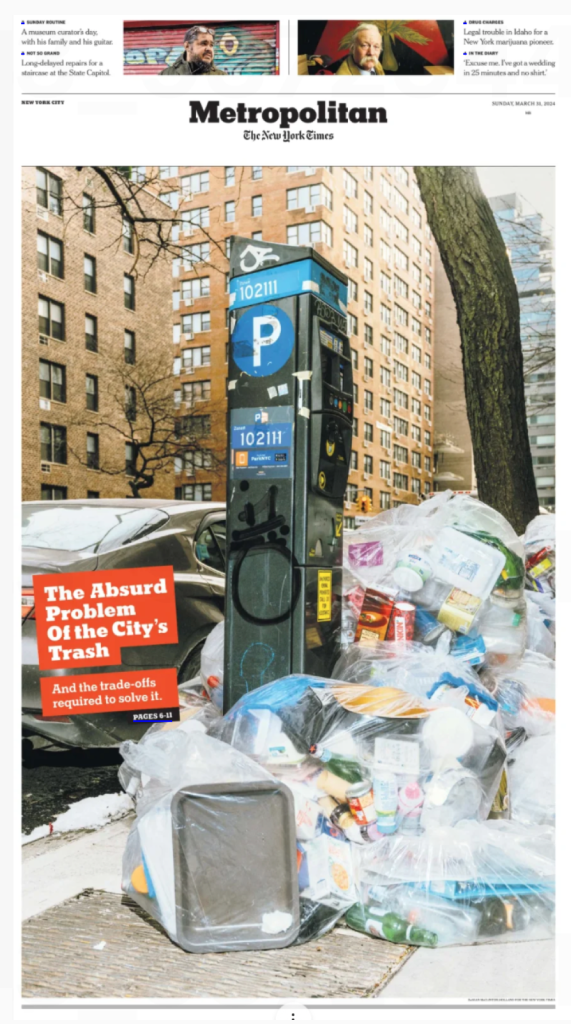
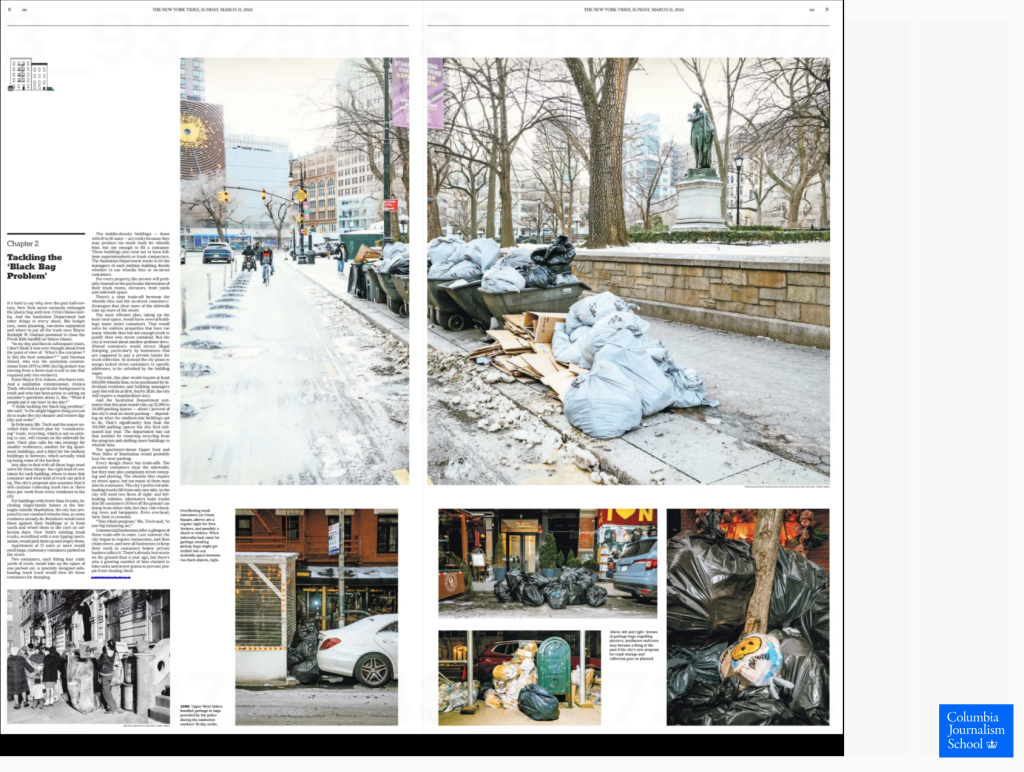
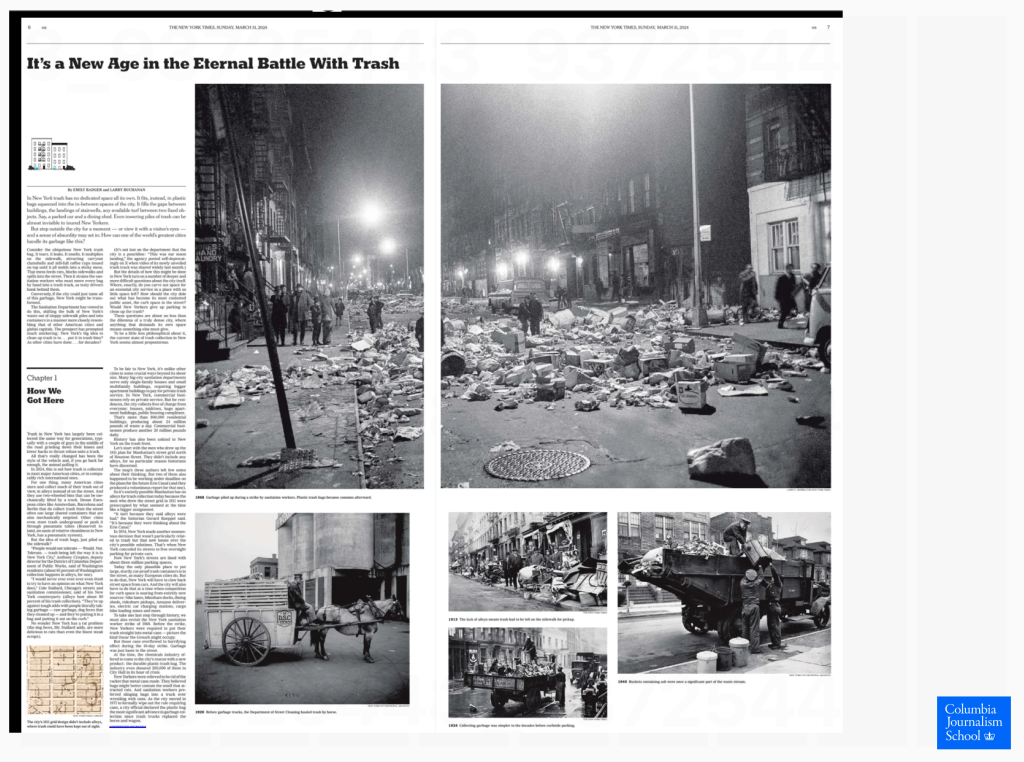
Do you believe print has a sustainable future? Why or why not?
Well, I think the future of print for most media houses will be as a supporting player, but not the protagonist. There may be weekend print editions, but it may not be financially smart to produce a daily print edition. Already we see experiments with print editions only a few times a week. If I were to put my money on it, I’d say bank on a rich weekend print edition that readers can enjoy as a lean back experience, relaxing and full of the surprises that a printed newspaper divided into sections can offer.
Print is not the star of the show anymore—digital has claimed that spotlight—but print retains a unique allure that ensures its relevance, particularly in a reimagined, more selective format.
The economics of daily print editions are increasingly untenable for many media houses. Innovative publishers are pivoting to less frequent print cycles. For instance, titles like The Independent in the UK and The Tampa Bay Times in the US have experimented with reduced schedules, publishing print editions only a few days a week, with a focus on high-impact weekend editions.
If I were to wager on print’s future, I’d put my chips on robust weekend editions. These offer a “lean-back” experience—think sinking into a cozy armchair with a cup of coffee, savoring the tactile joy of newsprint. A World Association of News Publishers study in 2025 found that 78% of print readers cherish weekend editions for their immersive, distraction-free quality, with 62% citing the joy of stumbling upon unexpected stories as a key draw. So, yes to print in the future, but in a reduced capacity and definitely not for everyone on your subscribers’ list.
How can editorial design evolve to make print more engaging for modern readers?
I think print is the platform for long reads, so avoid those columns of briefs so popular in the 80s and 90s. And, please, design each page around a large photo. Yes, six columns all the way across the page. Readers crave these visual exploits in print that are NOT possible on the smaller canvases of digital platforms. Let video be the protagonist for digital, but let those big photos dominate print. Allow for white space, since readers who come with a digital mentality do not take well to pages that are packed with type, butting headlines and many small photos that give the pages a sort of visual rash. And yet the design of print should also convey that this is a newspaper in the first two seconds when the reader lands on the page. Color is important, and readers who bring a digital mentality to print celebrate color coding for sections, for example.
What are some innovative design strategies that have helped retain or grow print readership?
I think that this begins with the editors of the print editions writing headlines that advance stories, not those that tell you what you already know.
Today’s printed newspaper needs to be done as a follow up to the news. Nobody comes to a printed newspaper for breaking news. I know that this is hard for editors to accept. But it is a reality.
Can you share examples where design alone significantly influenced the impact of a printed story?
During Covid, we saw many examples, but this one from The New York Times resonates with me, it stays with you years after the story impacted us.
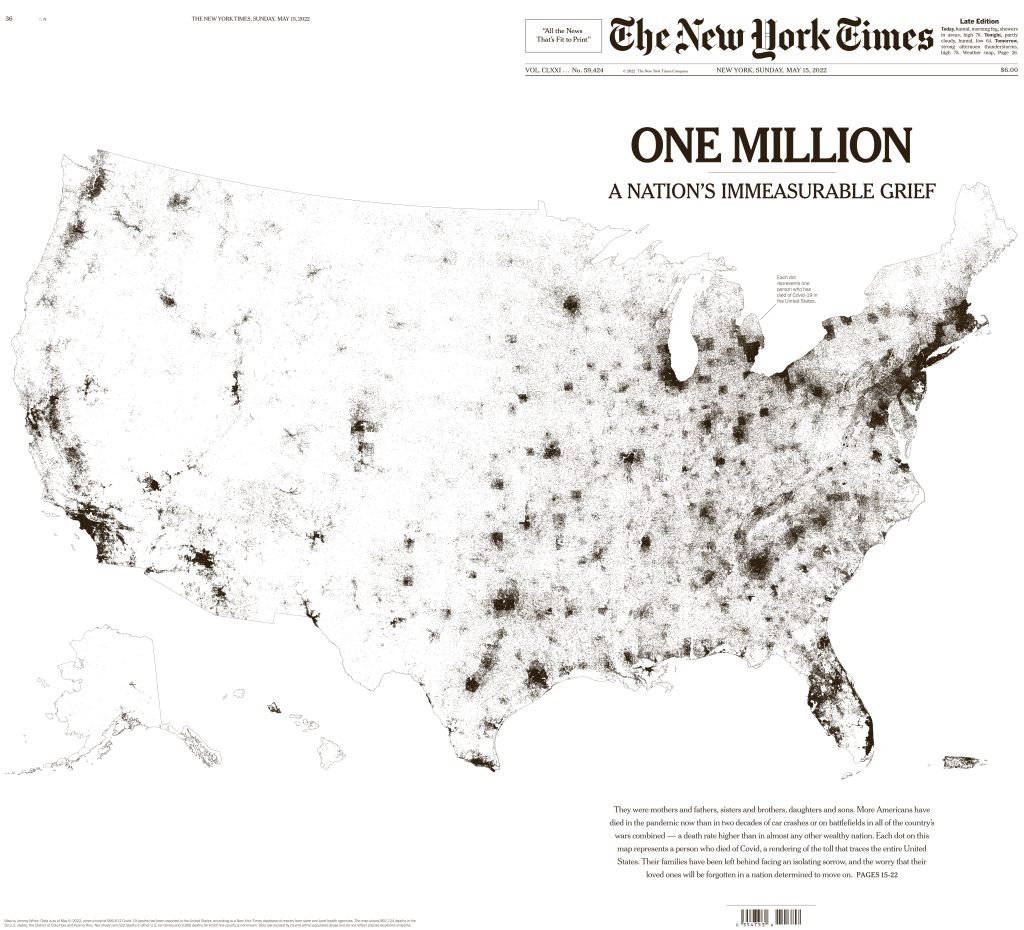
What are some successful strategies you’ve seen (or implemented) to reignite public interest in newspapers or magazines?
I think the best examples here are where the subscription package makes getting print editions, especially weekend, attractive. This is one way to promote the existence of the printed newspaper to a digitally minded audience. More specifically:
A key strategy is designing subscription packages that position print, especially weekend editions, as a premium, high-value component of a broader digital-print bundle. Publications like The New York Times have successfully implemented this, with their “All Access” subscription model combining digital access, mobile apps, and print delivery (notably the robust Sunday edition) to attract readers who value both immediacy and the leisurely “lean-back” experience of print. In 2024, The New York Times reported 10.7 million total subscribers, with print subscriptions still contributing significantly, generating over $750 million in revenue despite a 12.4% decline in print ad revenue.
To attract digitally minded audiences, publishers are using digital platforms to promote print subscriptions through targeted campaigns and interactive elements. For instance, The Economist integrates its print edition with its app, offering previews of print-exclusive content to entice digital users, contributing to a 10% growth in print-digital bundle subscriptions in 2024.
Then there are the old marketing strategies, such as adopting flexible pricing models, as discounted trials or tiered bundles.
How can print media appeal to younger audiences who grew up in a digital-first world?
I believe strongly that this is almost impossible. In my experience, this is a challenge that requires time and effort that is better invested in creating better print editions and targeting readers over 35 years of age. I may be alone in thinking this way, but I base my answer on the many projects in which I have participated globally. This is a no go.
Should print publications reposition themselves as premium, collectible, or niche products?
No, not really. I think that print products should appear proudly as representing history, authenticity and a more lean back, relaxed way of consuming the news. Once we attach collectible to the description, we are implying rare and old, neither which is a good marketing tool.
What role can community-focused content play in strengthening local print editions?
This has nothing to do with the platform itself. Nothing beats local content. Local content reigns supreme in any platform.
How do you see print and digital platforms complementing each other?
Each should try to be what it can do best. Digital and video, great pair; print and large photos, an unbeatable combo.
Is a hybrid model the way forward, or should publications fully commit to one format?
Each format has its advantages. Today, the digital format is what audiences crave and, in my view, the future. I do not believe in a hybrid model.
How can design teams work cohesively across print and digital without compromising on either?
Design teams need to become experts at what each platform can do best, but there are some design essentials that apply across platforms: legible type, easy to understand story structures, and well defined color palettes,
What skills should future designers and editors develop to succeed in this blended media environment?
The designer of now already needs to be Multiplatform driven and trained. In fact ,the course I teach at Columbia University is precisely that—Multiplatform design and storytelling.
What would be your advice to emerging designers or editors who are passionate about working in print?
Do what I try to do: I don’t romance print, I romance storytelling and today we can tell stories through a variety of platforms. Embrace and celebrate storytelling and visuals across platforms.
What’s one print innovation or project you’re most proud of, and why?
I truly admire The New York Times constant experimentation with its print editions, using larger images and graphics, and sometimes abandoning their front page standard format to surprise the reader with visuals that resonate. For a title that has been called The Old Gray Lady, the Times continues to surprise with its print edition——the care and attention that still goes into making this great newspaper a real textbook case for how to handle print in the digital age. Bravo to the Times team.
If you had to reinvent the print newspaper today from scratch, what core elements would you retain—and what would you redesign completely?
I will have a one section newspaper with impeccable navigational tools on page one, only summaries to start, then dance into pages dominated by one page stories and visuals, and forget sectionalizing and simply let the reader turn the pages, lean back and enjoy. I would settle for a 24 page newspaper where each page surprises me with the content and the visuals, all curated by editors who know that nothing beats a printed newspaper for a relaxed experience full of surprises.
Interesting that in 1999 a group of us designers met at the American Press Institute for a seminar to imagine how a printed newspaper be in 2020. Here are my versions of 1999 and 2020. I still think that this is how I envision an effective printed newspaper today, inspired by digital home pages, but with a newspaper look and feel that is distinctive and reflects legacy and authenticity.
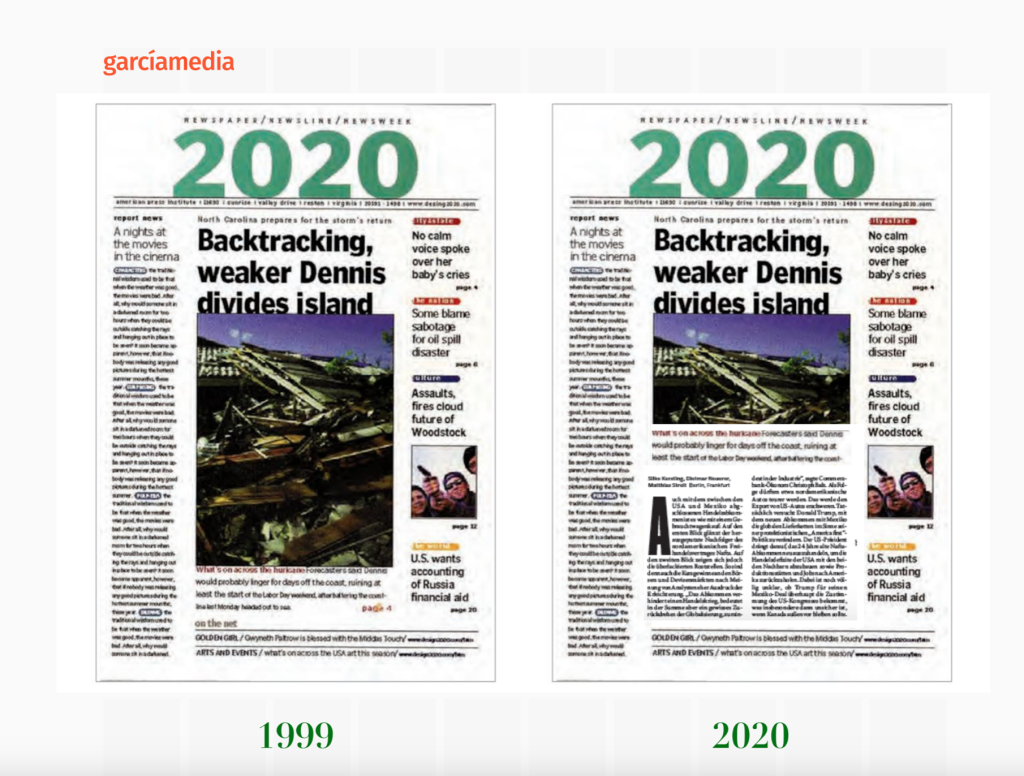
And here is County Highway, a new but very retro looking newspaper that appeared during the Covid era. In their own words:
“County Highway was born during the Covid lockdowns, when many of our friends and acquaintances became disillusioned by large cities. Some of us found new places that we loved. Some of us have always preferred the countryside or wild places. Some of us stayed in cities but began seeing how the ways of living and thinking that they cultivate might be a threat to the basic human pursuit of happiness and pleasure, and our ability to create without crippling self-censorship.
Some of us fear the specter of an incipient totalitarianism emerging from our laptops and iPhones. Some of us are simply allergic to conformity and brand-names. What we share in common is a revulsion at the smugness, sterility, and shitty aesthetics of the culture being forced upon us by monopoly tech platforms and corporate media, and a desire to make something better. We encourage you to think of our publication as a kind of hand-made alternative to the undifferentiated blob of electronic “content” that you scroll through every morning, most of which is produced by robots.”
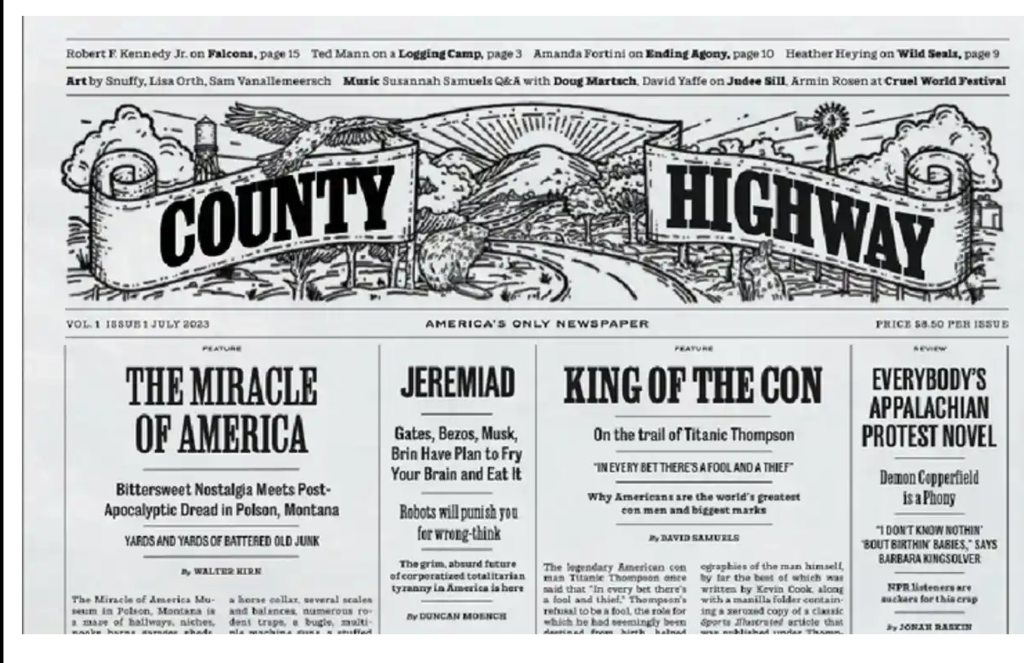
And finally, one project that I am very proud of—the new print edition look of Germany’s Handelsblatt, the financial daily:
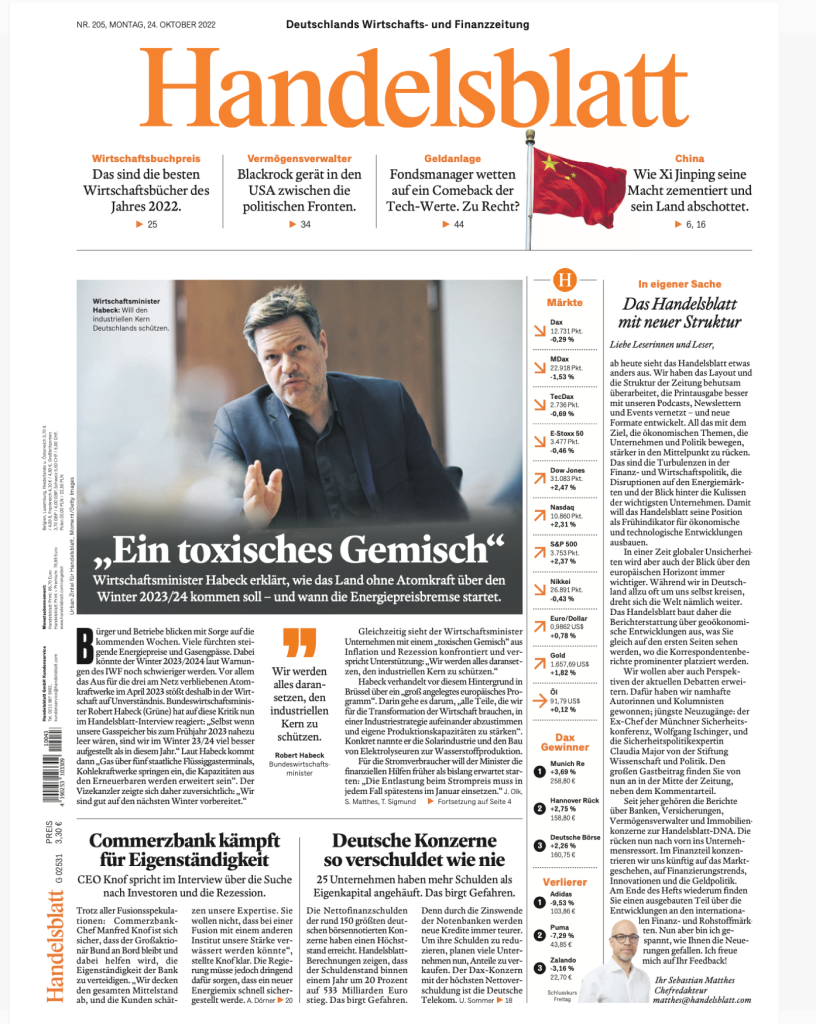
![]()





